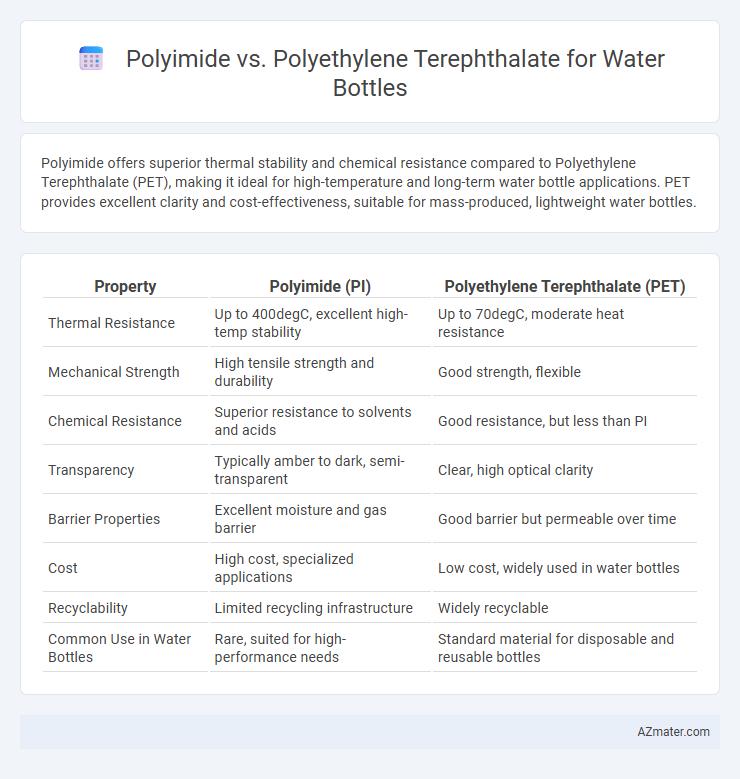Polyimide offers superior thermal stability and chemical resistance compared to Polyethylene Terephthalate (PET), making it ideal for high-temperature and long-term water bottle applications. PET provides excellent clarity and cost-effectiveness, suitable for mass-produced, lightweight water bottles.
Table of Comparison
| Property | Polyimide (PI) | Polyethylene Terephthalate (PET) |
|---|---|---|
| Thermal Resistance | Up to 400degC, excellent high-temp stability | Up to 70degC, moderate heat resistance |
| Mechanical Strength | High tensile strength and durability | Good strength, flexible |
| Chemical Resistance | Superior resistance to solvents and acids | Good resistance, but less than PI |
| Transparency | Typically amber to dark, semi-transparent | Clear, high optical clarity |
| Barrier Properties | Excellent moisture and gas barrier | Good barrier but permeable over time |
| Cost | High cost, specialized applications | Low cost, widely used in water bottles |
| Recyclability | Limited recycling infrastructure | Widely recyclable |
| Common Use in Water Bottles | Rare, suited for high-performance needs | Standard material for disposable and reusable bottles |
Introduction to Polyimide and Polyethylene Terephthalate
Polyimide is a high-performance polymer known for its exceptional thermal stability, mechanical strength, and chemical resistance, making it suitable for advanced applications requiring durability and reliability. Polyethylene terephthalate (PET) is a widely used thermoplastic polyester characterized by its lightweight, excellent clarity, and strong barrier properties against moisture and gases, commonly found in everyday water bottles. The distinct molecular structures of polyimide and PET significantly influence their performance in water bottle manufacturing, particularly in terms of heat resistance, durability, and environmental impact.
Material Properties Comparison
Polyimide exhibits superior thermal stability, withstanding temperatures above 300degC, while polyethylene terephthalate (PET) typically degrades around 250degC, making polyimide ideal for high-temperature applications. Polyethylene terephthalate offers excellent clarity, lightweight properties, and high impact resistance, which are essential for consumer-friendly water bottles, whereas polyimide tends to be more opaque and rigid. Moisture barrier performance of polyimide surpasses PET, providing enhanced chemical resistance and durability, crucial for extending the shelf life of liquid contents.
Thermal Resistance: Polyimide vs PET
Polyimide exhibits superior thermal resistance compared to Polyethylene Terephthalate (PET), withstanding temperatures up to 400degC without deformation, whereas PET typically tolerates up to 70-80degC before softening. This high thermal stability makes polyimide ideal for applications requiring hot liquid containment or sterilization processes. PET offers adequate performance for standard water bottles but is less suitable for exposure to high temperatures due to its lower glass transition temperature.
Chemical Stability and Reactivity
Polyimide exhibits superior chemical stability and low reactivity compared to Polyethylene Terephthalate (PET), making it highly resistant to acids, bases, and solvents commonly encountered in water bottles. PET, while widely used due to its affordability and clarity, can degrade under prolonged exposure to heat, UV light, and certain chemicals, resulting in potential leaching and reduced durability. The enhanced chemical resistance of polyimide ensures better preservation of water quality and bottle integrity over time, especially in aggressive environments.
Mechanical Strength and Durability
Polyimide exhibits superior mechanical strength and durability compared to Polyethylene Terephthalate (PET), making it highly resistant to deformation and wear under stress. PET offers adequate strength for everyday water bottle use but is more prone to cracking and degradation over time, especially when exposed to heat or UV light. The exceptional thermal stability and chemical resistance of polyimide contribute to its long-lasting performance in demanding environments.
Safety and Food Contact Regulations
Polyimide exhibits high thermal stability and chemical resistance, making it suitable for water bottles requiring repeated sterilization without leaching harmful substances. Polyethylene terephthalate (PET) is widely accepted and regulated for food contact by agencies like the FDA and EFSA, ensuring its safety and compliance for beverage containers. While PET is more commonly used due to established food safety certifications, polyimide's advanced material properties require thorough regulatory evaluation before widespread adoption in food and beverage applications.
Environmental Impact and Recyclability
Polyimide water bottles exhibit high durability and thermal resistance, but their complex chemical structure makes recycling processes energy-intensive and less common compared to polyethylene terephthalate (PET). PET is widely recycled globally, with established infrastructure promoting efficient material recovery and significantly reducing environmental pollution. The biodegradable potential and lower carbon footprint of PET contribute to its favorable environmental impact over polyimide in single-use water bottle applications.
Cost Analysis and Manufacturing Considerations
Polyethylene terephthalate (PET) is significantly more cost-effective than polyimide for water bottle production due to its lower raw material and processing expenses. Manufacturing PET water bottles benefits from well-established, high-speed injection molding and blow molding techniques, ensuring economies of scale and faster production cycles. In contrast, polyimide involves higher processing temperatures and specialized equipment, leading to increased manufacturing complexity and costs that restrict its application in mass-produced water bottles.
Market Applications and Consumer Preferences
Polyethylene Terephthalate (PET) dominates the water bottle market due to its lightweight, high transparency, and cost-effectiveness, making it the preferred choice for mass-produced disposable bottles. Polyimide offers superior thermal stability and chemical resistance but is less common in consumer water bottles due to higher production costs and limited market demand. Consumers prioritize PET for convenience and affordability, while niche applications requiring durability and reusability may opt for polyimide-based bottles.
Conclusion: Selecting the Optimal Material for Water Bottles
Polyethylene Terephthalate (PET) remains the preferred choice for water bottles due to its exceptional clarity, lightweight nature, and cost-effectiveness. Polyimide offers superior thermal stability and chemical resistance but at a higher manufacturing expense, making it less practical for mass-produced water bottles. Selecting PET balances performance, affordability, and recyclability, optimizing consumer convenience and environmental impact.

Infographic: Polyimide vs Polyethylene Terephthalate for Water Bottle
 azmater.com
azmater.com